SLOVAKIA
From Vienna you can reach Bratislava, the Slovak capital, with a short one-hour ride on a train that almost looks like a metro line. It is frequented by Slovaks who work in Vienna next door and I instead had a strange and exciting encounter.
I sat at the end of the carriage to keep an eye on the bulky suitcase and in front of the corridor a tall, very sexy blonde girl sat down, dressed in a tight white and pink dress.
With my usual cheek I struck up a conversation and started conversing with her who left me speechless when she answered my question “What do you do for a living?”
Her response was: “I'm a porn model!” In short, a young Cicciolina!
The surprise then came when the girl was very sweet in consoling a crying little girl who her grandmother couldn't calm down. The porn model picked her up and cuddled her, giving her a small dolphin made of white fabric that she had taken from her suitcase.
In the end the girl became paranoid and almost had a nervous breakdown because she couldn't find her train ticket in front of the inflexible conductor. Luckily, while I was trying to console her and invite her to look calmly, she remembered that she had put the ticket in a side pocket of the suitcase. And everything was resolved to everyone's great satisfaction, including myself, struck by this unusual encounter which I had no opportunity to delve into further!
BRATISLAVA is a beautiful city of around 600 thousand inhabitants which runs along the Danube river with several boats docked along its banks and many modern bridges, one of which has a restaurant at great height above a circular column.
The historic center is nice, with a series of pedestrian streets with low, ancient houses at the base of which there are several outdoor bars and restaurants which come alive in the evening with the presence of locals and the many Austrian and German tourists who arrive in Slovakia for accessible prices even if the fact that the euro circulates, the only country together with Estonia in Eastern Europe, has caused previously very low prices to rise.
Slovakia has a good economy, better than the Hungarian one and produces many cars given that Volkswagen, French companies and the Korean Kia have built many branches there where more cars are produced than in Italy, thanks to low salaries and low tax pressure.< br /> Bratislava has a castle on a hill, a very high, white quadrilateral with a large internal courtyard and surrounding park which is undergoing restoration. It dates back to the 15th century and became the residence of the Hungarian royal family during the Turkish occupation of Budapest when the Hungarian capital was moved to Bratislava.
Below is the beautiful San Martin cathedral with its 8kg solid gold sphere on the bell tower. Many Hungarian kings were crowned in this church..
Relations are bad between the two states because the Slovaks fear Hungarian claims which the latter swear not to support.
There is a beautiful opera house in a square with a beautiful garden and a luxurious hotel, an ancient church on whose external wall is stuck the black cannon ball fired during an old conflict and the sign of the Danube which had flooded the city during a winter flood with the arrival of ice. A beautiful old town hall and interesting patrician buildings such as the Reduta and the Apponyi complete the historic center with the Roland fountain which dates back to 1500, some gates and towers and an ancient house one meter wide.
The modern part along the southern side of the Danube is very beautiful. There are ultra-modern buildings home to shopping centres, hotels and museums and a beautiful riverside promenade with English lawns and huge cushions where especially young people relax and drink cocktails while admiring the river and listening to background music.
Unfortunately, the communist regime has committed some disgraces, for example by building a motorway that passes right in front of the cathedral which is in danger and is undergoing restructuring and consolidation. There are imposing classic buildings, but also horrible communist ones, which can be seen in the distance across the river, very tall and colorful buildings all the same that form the city built after the war by the communist regime.
I thought one day was enough and so I decided to move on and visit other places in the country. I would have liked to stop in Trencin, a beautiful ancient town with a castle, but unfortunately I didn't realize I had passed it due to a sudden dozing off.
Luckily I stopped immediately afterwards in PIESTANY, a town with thermal baths and spas with a river, a beautiful, quiet and green town and an impressive spa complex, the Napoleon with three structures.
I decided to try the experience of bathing in black mud and then in very hot and sulphurous water with drinking about six liters of very hot water considered miraculous for the stomach acid from which I unfortunately suffer, often due to the beer which I would have to give up.
In short, I tried to make up for the many beers I drank with this disproportionate amount of hot water and a bath which caused me, during the half hour of rest in bed, to sweat excessively, but perhaps healthy. On the other hand, this experience only cost me 13 euros and in the following days I felt reborn.
The next non-stop stop was the Tatra Mountains and its national parks. Slovakia is attacked above all for its mountains, but I was lucky enough to climb Mount Lonmin, one of the highest of the Tatras, during an excursion from Zakopane in Poland the previous year and so I continued and stopped in SPISK NOVA VES, a nice town, in total restoration which was very convenient for two excursions the following day.
I stayed in a modern hotel and took the most expensive room of the whole trip: 35 euros for a single room with bathroom, television, air conditioning and spa system on the ground floor with free use of the Finnish dry sauna and the Turkish steam sauna.
After the tiredness of the interminable half-day train journey, I appreciated this relaxing experience which gave me the opportunity to meet various young Slovakian couples who usually spend the weekend with excursions in the mountains and sauna sessions in the evening.
Furthermore, after leaving the sauna and intending to dine in the hotel's beautiful restaurant, I discovered that the entire place was intended for the wedding party of a beautiful couple. I stopped on the terrace, listening to the music of the band, the dances of the relatives and their libations which lasted day and night for three meals as I learned from two local girls invited with whom I managed to exchange a brief conversation and who rewarded me with the The offer of the wedding cake, some pastries and some Slovakian sparkling wine, not bad.
Not full I decided to find a restaurant for a full dinner and I was lucky to find an excellent, characteristic and very original place with furniture made of antique objects from the Slovakian house from times gone by. Strangely, I don't remember what I ate, but I was satisfied and paid around 10 euros.
The next day I took a local train and reached LEVOCA, a medieval town surrounded by ancient walls and towers with some beautiful buildings inside and a beautiful church where I attended Sunday mass, noting the profound religiosity of the Slovaks and appreciating the songs of the choir accompanied by that of the faithful.
By coach I continued to SPISSKE PODHRADJE a beautiful quiet town in a green valley which is home to two interesting attractions: the monastery and the ancient church of St. Martin, a convent and ancient walls dating back to 1200 in a religious complex called Kapitula just outside the city on a low panoramic hill and on the other side the most photographed site in Slovakia: the SPIS castle fortress which can be reached on foot by climbing a very long path that climbs gradually but which was heavy at midday with the sun perpendicular.
It dates back to 1200 and is one of the largest in Europe which served to defend the local populations from the Tartars.
Fortunately, the visit, the panoramic view, the rooms with the ancient kitchen, a small internal church, some medieval weapons, the prison, the torture room, but above all the grandeur and the panoramic position made the visit worthwhile which constitutes one of the main attractions of the country.
In fact I had discovered that by leaving immediately I could have arrived in Budapest by the evening with an excellent and comfortable intercity train which otherwise I would have had to take very early in the morning with a very early rise which I had no intention of doing.
Da Vienna si raggiunge Bratislava, la capitale slovacca con una breve corsa di un'ora in un treno che sembra quasi una linea di metrò. E' frequentata da slovacchi che lavorano nella dirimpettaia Vienna ed io invece ho fatto uno strano ed eccitante incontro.
Mi sono seduto in fondo alla carrozza per tenere d'occhio la valigia ingombrante e dirimpetto al corridoio si è accomodata una ragazza alta e bionda molto sexy, vestita con un abito aderente dal colore bianco e rosa.
Con la mia solita faccia tosta ho attaccato bottone e mi sono messo a conversare con lei che mi ha lasciato a bocca aperta quando ha risposto alla mia domanda “Che lavoro fai?”
La risposta è stata: “Faccio la pornomodella!” Insomma una giovane Cicciolina!
La sorpresa poi è stata quando la ragazza è stata molto dolce a consolare una bambina che piangeva e che la nonna non riusciva a calmare. La pornomodella l'ha presa in braccio e coccolata, regalandole un piccolo delfino di stoffa bianca che aveva preso dalla valigia.
Alla fine la ragazza andò in paranoia ed ebbe quasi una crisi nervosa perchè non riusciva a trovare il biglietto del treno davanti all'inflessibile controllore. Per fortuna, mentre cercavo di consolarla e invitarla a cercare con calma, si ricordò di aver messo il biglietto in una tasca laterale della valigia. E tutto si risolse con grande soddisfazione di tutti, anche del sottoscritto, colpito da questo insolito incontro che non ebbi modo.....di approfondire!
BRATISLAVA è una bella città da circa 600 mila abitanti che si svolge lungo il fiume Danubio con parecchi battelli attraccati lungo le sue rive e tanti ponti moderni di cui uno con un ristorante a grande altezza sopra una colonna circolare.
Il centro storico è carino, con una serie di strade pedonali con case basse e antiche alle cui basi si trovano parecchi bar e ristoranti all'aperto che la sera si animano con la presenza dei locali e dei tanti turisti austriaci e tedeschi che arrivano in Slovacchia per i prezzi accessibili anche se il fatto che circoli l'euro, unico paese assieme all'Estonia in Europa orientale, ha fatto salire i prezzi prima bassissimi.
La Slovacchia ha una buona economia, migliore di quella ungherese e produce molte automobili dato che Volkswagen,case francesi e la Kia coreana vi hanno costruito tante filiali dove si producono più auto che in Italia, grazie ai bassi stipendi e la bassa pressione fiscale.
Bratislava possiede un castello in collina, un quadrilatero altissimo e bianco con grande cortile interno e parco circostante in corsi di restauro. Risale al XV secolo e divenne residenza della famiglia reale ungherese durante l'occupazione turca di Budapest quando la capitale ungherese venne trasferita a Bratislava.
Di sotto la bella cattedrale di San Martin con la sua sfera di oro massiccio da 8 kg sul campanile. In questa chiesa vennero incoronati molti re ungheresi..
I rapporti sono pessimi fra i due stati perchè gli slovacchi temono le rivendicazioni ungheresi che questi ultimi giurano di non sostenere.
Vi è un bel teatro dell'Opera in una piazza con bel giardino e albergo lussuoso, una chiesa antica sulla cui parete esterna è incastrata la palla nera di cannone sparata durante un vecchio conflitto ed il segno del Danubio che aveva allagato la città durante un'alluvione invernale con l'arrivo del ghiaccio. Un bel municipio antico e palazzi patrizi interessanti come il Reduta e l'Apponyi completano il centro storico con la fontana di Rolando che risale al 1500, alcune porte e torrioni ed una casa antica larga un metro.
Molto bella la parte moderna lungo il lato meridionale del Danubio. Vi sono edifici ultra-moderni sede di centri commerciali, alberghi e musei ed una bella passeggiata lungofiume con prati all'inglese ed enormi cuscini dove soprattutto i giovani si distendono e bevono cocktail ammirando il fiume ed ascoltando la musica di sottofondo.
Purtroppo il regime comunista ha compiuto degli obbrobri, per esempio costruendo un'autostrada che passa proprio davanti la cattedrale messa in pericolo ed in fase di ristrutturazione e consolidamento. Vi sono palazzi classici imponenti, ma anche quelli orribili di impronta comunista, che si vedono in distanza oltre il fiume, palazzi altissimi e colorati tutti uguali che formano la città c costruita nel dopoguerra dal regime comunista.
Ho pensato che un giorno fosse sufficiente e così decisi di passare oltre e visitare altre località del paese. Avrei voluto fermarmi a Trencin una bella cittadina antica con castello, ma purtroppo non mi accorsi di averla passata per un improvviso appisolamento.
Per fortuna mi fermai subito dopo a PIESTANY, una località sede di terme e spa con fiume, bella cittadina tranquilla e verde ed un imponente complesso termale, il Napoleon con ben tre strutture.
Decisi di provare l'esperienza del bagno nei fanghi neri e poi nell'acqua caldissima e solforosa con bevuta di circa sei litri di acqua caldissima ritenuta miracolosa per l'acidità di stomaco di cui purtroppo soffro, spesso per colpa della birra cui dovrei rinunciare.
Insomma ho cercato di rimediare alle tante birre bevute con questa bevuta spropositata di acqua calda e del bagno che mi procurò, nella mezzora di riposo a letto, una sudorazione eccessiva, ma forse salutare. In compenso questa esperienza mi costò solo 13 euro e nei giorni successivi mi sentii rinato.
La prossima tappa senza fermata furono i monti Tatra ed i suoi parchi nazionali. La Slovacchia viene prese d'assalto soprattutto per le sue montagne, ma io ebbi la fortuna di salire il monte Lonmin, uno dei più alti dei Tatra, durante un'escursione da Zakopane in Polonia dell'anno precedente e così proseguii e mi fermai a SPISK NOVA VES, una cittadina simpatica, in totale restauro che fu molto comoda per due escursioni del giorno successivo.
Alloggiai in un albergo moderno e presi la stanza più cara di tutto il viaggio: 35 euro per una singola con bagno, televisione, aria condizionata e impianto termale al pianterreno con uso gratuito della sauna secca finlandese e di quella a vapore turca.
Dopo la stanchezza del viaggio interminabile in treno durato mezza giornata, apprezzai questa rilassante esperienza che mi diede modo di incontrare varie coppie di giovani slovacchi che usano trascorrere il week-end con escursioni in montagna e sedute di sauna in serata.
In più, uscito dalla sauna e intenzionato a cenare nel bel ristorante dell'albergo, scoprii che l'intero locale era destinato alla festa di matrimonio di una bella coppia. Mi fermai in terrazza, ascoltando la musica del complessino, i balli dei parenti e le loro libagioni che duravano giorno e notte per ben tre pasti come appreso da due ragazze locali invitate con le quali riuscii a scambiare una breve conversazione e che mi gratificarono con l'offerta della torta nuziale, di alcuni pasticcini e dello spumante slovacco, niente male.
Non sazio decisi di trovare un ristorante per una cena completa e fui fortunato a trovare un ottimo locale caratteristico e molto originale con un arredamento di oggetti antichi della casa slovacca di altri tempi. Stranamente non ricordo cosa mangiai, ma fui soddisfatto e pagai circa 10 euro.
Il giorno dopo presi un treno locale e raggiunsi LEVOCA una cittadina medioevale circondata da antiche mura e torrioni con alcuni bei palazzi all'interno ed una bella chiesa dove assistetti alla messa domenicale notando la profonda religiosità degli slovacchi e apprezzando i canti del coro accompagnato da quello dei fedeli.
Con pullman proseguii per SPISSKE PODHRADJE una bella cittadina tranquilla in una vallata verde che ospita due interessanti attrazioni: il monastero e l'antica chiesa di.S.Martin, un convento e antiche mura risalenti al 1200 in un complesso religioso chiamato Kapitula appena fuori città in una bassa collina panoramica e dall'altra parte il sito più fotografato della Slovacchia: il castello fortezza di SPIS che si raggiunge a piedi salendo una lunghissimo sentiero che sale gradatamente ma che fu pesante a mezzogiorno col sole a perpendicolo.
Risale al 1200 ed è uno dei più vasti d'Europa che servì a difendere le popolazioni locali dai Tartari.
Fortunatamente la visita, lo spettacolo panoramico, le sale con la cucina antica, una chiesetta interna, alcune armi medioevali, la prigione, la stanza delle torture, ma soprattutto la grandiosità e la posizione panoramica resero meritevole quella visita che costituisce una delle principali attrazioni del paese.
L'ultima tappa slovacca fu la città di KOZICE, seconda città slovacca che si trova vicino al confine con.l'Ungheria dove avrei dovuto fermarmi la notte, ma per una serie di circostanze sfortunate decisi che la visita di un paio d'ore poteva bastare.
Insomma cercai un ostello che non esisteva e gli alberghi erano piuttosto cari, oltre 50 euro per stanza e nel frattempo girando alla ricerca mi accorsi che avevo visto tutto il centro storico, molto bello, una via molto larga centrale con la bella catterale di S.ta Elisabetta con bel campanile, la cappella di S.Michele, una torre cittadina, una fontana spettacolare che manda zampilli a tempo di musica classica, molti giardini e palazzi curati, perfino alcuni scavi archeologici ed una festa in piazza con concerto rap di gruppi di giovani slovacchi e ragazzine isteriche sottostanti inneggianti ai loro idoli.
In effetti avevo scoperto che partendo subito avrei potuto arrivare a Budapest entro la serata con ottimo e comodo intercity che altrimenti avrei dovuto prendere la mattina molto presto con alzataccia che non avevo intenzione di fare.
I sat at the end of the carriage to keep an eye on the bulky suitcase and in front of the corridor a tall, very sexy blonde girl sat down, dressed in a tight white and pink dress.
With my usual cheek I struck up a conversation and started conversing with her who left me speechless when she answered my question “What do you do for a living?”
Her response was: “I'm a porn model!” In short, a young Cicciolina!
The surprise then came when the girl was very sweet in consoling a crying little girl who her grandmother couldn't calm down. The porn model picked her up and cuddled her, giving her a small dolphin made of white fabric that she had taken from her suitcase.
In the end the girl became paranoid and almost had a nervous breakdown because she couldn't find her train ticket in front of the inflexible conductor. Luckily, while I was trying to console her and invite her to look calmly, she remembered that she had put the ticket in a side pocket of the suitcase. And everything was resolved to everyone's great satisfaction, including myself, struck by this unusual encounter which I had no opportunity to delve into further!
BRATISLAVA is a beautiful city of around 600 thousand inhabitants which runs along the Danube river with several boats docked along its banks and many modern bridges, one of which has a restaurant at great height above a circular column.
The historic center is nice, with a series of pedestrian streets with low, ancient houses at the base of which there are several outdoor bars and restaurants which come alive in the evening with the presence of locals and the many Austrian and German tourists who arrive in Slovakia for accessible prices even if the fact that the euro circulates, the only country together with Estonia in Eastern Europe, has caused previously very low prices to rise.
Slovakia has a good economy, better than the Hungarian one and produces many cars given that Volkswagen, French companies and the Korean Kia have built many branches there where more cars are produced than in Italy, thanks to low salaries and low tax pressure.< br /> Bratislava has a castle on a hill, a very high, white quadrilateral with a large internal courtyard and surrounding park which is undergoing restoration. It dates back to the 15th century and became the residence of the Hungarian royal family during the Turkish occupation of Budapest when the Hungarian capital was moved to Bratislava.
Below is the beautiful San Martin cathedral with its 8kg solid gold sphere on the bell tower. Many Hungarian kings were crowned in this church..
Relations are bad between the two states because the Slovaks fear Hungarian claims which the latter swear not to support.
There is a beautiful opera house in a square with a beautiful garden and a luxurious hotel, an ancient church on whose external wall is stuck the black cannon ball fired during an old conflict and the sign of the Danube which had flooded the city during a winter flood with the arrival of ice. A beautiful old town hall and interesting patrician buildings such as the Reduta and the Apponyi complete the historic center with the Roland fountain which dates back to 1500, some gates and towers and an ancient house one meter wide.
The modern part along the southern side of the Danube is very beautiful. There are ultra-modern buildings home to shopping centres, hotels and museums and a beautiful riverside promenade with English lawns and huge cushions where especially young people relax and drink cocktails while admiring the river and listening to background music.
Unfortunately, the communist regime has committed some disgraces, for example by building a motorway that passes right in front of the cathedral which is in danger and is undergoing restructuring and consolidation. There are imposing classic buildings, but also horrible communist ones, which can be seen in the distance across the river, very tall and colorful buildings all the same that form the city built after the war by the communist regime.
I thought one day was enough and so I decided to move on and visit other places in the country. I would have liked to stop in Trencin, a beautiful ancient town with a castle, but unfortunately I didn't realize I had passed it due to a sudden dozing off.
Luckily I stopped immediately afterwards in PIESTANY, a town with thermal baths and spas with a river, a beautiful, quiet and green town and an impressive spa complex, the Napoleon with three structures.
I decided to try the experience of bathing in black mud and then in very hot and sulphurous water with drinking about six liters of very hot water considered miraculous for the stomach acid from which I unfortunately suffer, often due to the beer which I would have to give up.
In short, I tried to make up for the many beers I drank with this disproportionate amount of hot water and a bath which caused me, during the half hour of rest in bed, to sweat excessively, but perhaps healthy. On the other hand, this experience only cost me 13 euros and in the following days I felt reborn.
The next non-stop stop was the Tatra Mountains and its national parks. Slovakia is attacked above all for its mountains, but I was lucky enough to climb Mount Lonmin, one of the highest of the Tatras, during an excursion from Zakopane in Poland the previous year and so I continued and stopped in SPISK NOVA VES, a nice town, in total restoration which was very convenient for two excursions the following day.
I stayed in a modern hotel and took the most expensive room of the whole trip: 35 euros for a single room with bathroom, television, air conditioning and spa system on the ground floor with free use of the Finnish dry sauna and the Turkish steam sauna.
After the tiredness of the interminable half-day train journey, I appreciated this relaxing experience which gave me the opportunity to meet various young Slovakian couples who usually spend the weekend with excursions in the mountains and sauna sessions in the evening.
Furthermore, after leaving the sauna and intending to dine in the hotel's beautiful restaurant, I discovered that the entire place was intended for the wedding party of a beautiful couple. I stopped on the terrace, listening to the music of the band, the dances of the relatives and their libations which lasted day and night for three meals as I learned from two local girls invited with whom I managed to exchange a brief conversation and who rewarded me with the The offer of the wedding cake, some pastries and some Slovakian sparkling wine, not bad.
Not full I decided to find a restaurant for a full dinner and I was lucky to find an excellent, characteristic and very original place with furniture made of antique objects from the Slovakian house from times gone by. Strangely, I don't remember what I ate, but I was satisfied and paid around 10 euros.
The next day I took a local train and reached LEVOCA, a medieval town surrounded by ancient walls and towers with some beautiful buildings inside and a beautiful church where I attended Sunday mass, noting the profound religiosity of the Slovaks and appreciating the songs of the choir accompanied by that of the faithful.
By coach I continued to SPISSKE PODHRADJE a beautiful quiet town in a green valley which is home to two interesting attractions: the monastery and the ancient church of St. Martin, a convent and ancient walls dating back to 1200 in a religious complex called Kapitula just outside the city on a low panoramic hill and on the other side the most photographed site in Slovakia: the SPIS castle fortress which can be reached on foot by climbing a very long path that climbs gradually but which was heavy at midday with the sun perpendicular.
It dates back to 1200 and is one of the largest in Europe which served to defend the local populations from the Tartars.
Fortunately, the visit, the panoramic view, the rooms with the ancient kitchen, a small internal church, some medieval weapons, the prison, the torture room, but above all the grandeur and the panoramic position made the visit worthwhile which constitutes one of the main attractions of the country.
In fact I had discovered that by leaving immediately I could have arrived in Budapest by the evening with an excellent and comfortable intercity train which otherwise I would have had to take very early in the morning with a very early rise which I had no intention of doing.
Da Vienna si raggiunge Bratislava, la capitale slovacca con una breve corsa di un'ora in un treno che sembra quasi una linea di metrò. E' frequentata da slovacchi che lavorano nella dirimpettaia Vienna ed io invece ho fatto uno strano ed eccitante incontro.
Mi sono seduto in fondo alla carrozza per tenere d'occhio la valigia ingombrante e dirimpetto al corridoio si è accomodata una ragazza alta e bionda molto sexy, vestita con un abito aderente dal colore bianco e rosa.
Con la mia solita faccia tosta ho attaccato bottone e mi sono messo a conversare con lei che mi ha lasciato a bocca aperta quando ha risposto alla mia domanda “Che lavoro fai?”
La risposta è stata: “Faccio la pornomodella!” Insomma una giovane Cicciolina!
La sorpresa poi è stata quando la ragazza è stata molto dolce a consolare una bambina che piangeva e che la nonna non riusciva a calmare. La pornomodella l'ha presa in braccio e coccolata, regalandole un piccolo delfino di stoffa bianca che aveva preso dalla valigia.
Alla fine la ragazza andò in paranoia ed ebbe quasi una crisi nervosa perchè non riusciva a trovare il biglietto del treno davanti all'inflessibile controllore. Per fortuna, mentre cercavo di consolarla e invitarla a cercare con calma, si ricordò di aver messo il biglietto in una tasca laterale della valigia. E tutto si risolse con grande soddisfazione di tutti, anche del sottoscritto, colpito da questo insolito incontro che non ebbi modo.....di approfondire!
BRATISLAVA è una bella città da circa 600 mila abitanti che si svolge lungo il fiume Danubio con parecchi battelli attraccati lungo le sue rive e tanti ponti moderni di cui uno con un ristorante a grande altezza sopra una colonna circolare.
Il centro storico è carino, con una serie di strade pedonali con case basse e antiche alle cui basi si trovano parecchi bar e ristoranti all'aperto che la sera si animano con la presenza dei locali e dei tanti turisti austriaci e tedeschi che arrivano in Slovacchia per i prezzi accessibili anche se il fatto che circoli l'euro, unico paese assieme all'Estonia in Europa orientale, ha fatto salire i prezzi prima bassissimi.
La Slovacchia ha una buona economia, migliore di quella ungherese e produce molte automobili dato che Volkswagen,case francesi e la Kia coreana vi hanno costruito tante filiali dove si producono più auto che in Italia, grazie ai bassi stipendi e la bassa pressione fiscale.
Bratislava possiede un castello in collina, un quadrilatero altissimo e bianco con grande cortile interno e parco circostante in corsi di restauro. Risale al XV secolo e divenne residenza della famiglia reale ungherese durante l'occupazione turca di Budapest quando la capitale ungherese venne trasferita a Bratislava.
Di sotto la bella cattedrale di San Martin con la sua sfera di oro massiccio da 8 kg sul campanile. In questa chiesa vennero incoronati molti re ungheresi..
I rapporti sono pessimi fra i due stati perchè gli slovacchi temono le rivendicazioni ungheresi che questi ultimi giurano di non sostenere.
Vi è un bel teatro dell'Opera in una piazza con bel giardino e albergo lussuoso, una chiesa antica sulla cui parete esterna è incastrata la palla nera di cannone sparata durante un vecchio conflitto ed il segno del Danubio che aveva allagato la città durante un'alluvione invernale con l'arrivo del ghiaccio. Un bel municipio antico e palazzi patrizi interessanti come il Reduta e l'Apponyi completano il centro storico con la fontana di Rolando che risale al 1500, alcune porte e torrioni ed una casa antica larga un metro.
Molto bella la parte moderna lungo il lato meridionale del Danubio. Vi sono edifici ultra-moderni sede di centri commerciali, alberghi e musei ed una bella passeggiata lungofiume con prati all'inglese ed enormi cuscini dove soprattutto i giovani si distendono e bevono cocktail ammirando il fiume ed ascoltando la musica di sottofondo.
Purtroppo il regime comunista ha compiuto degli obbrobri, per esempio costruendo un'autostrada che passa proprio davanti la cattedrale messa in pericolo ed in fase di ristrutturazione e consolidamento. Vi sono palazzi classici imponenti, ma anche quelli orribili di impronta comunista, che si vedono in distanza oltre il fiume, palazzi altissimi e colorati tutti uguali che formano la città c costruita nel dopoguerra dal regime comunista.
Ho pensato che un giorno fosse sufficiente e così decisi di passare oltre e visitare altre località del paese. Avrei voluto fermarmi a Trencin una bella cittadina antica con castello, ma purtroppo non mi accorsi di averla passata per un improvviso appisolamento.
Per fortuna mi fermai subito dopo a PIESTANY, una località sede di terme e spa con fiume, bella cittadina tranquilla e verde ed un imponente complesso termale, il Napoleon con ben tre strutture.
Decisi di provare l'esperienza del bagno nei fanghi neri e poi nell'acqua caldissima e solforosa con bevuta di circa sei litri di acqua caldissima ritenuta miracolosa per l'acidità di stomaco di cui purtroppo soffro, spesso per colpa della birra cui dovrei rinunciare.
Insomma ho cercato di rimediare alle tante birre bevute con questa bevuta spropositata di acqua calda e del bagno che mi procurò, nella mezzora di riposo a letto, una sudorazione eccessiva, ma forse salutare. In compenso questa esperienza mi costò solo 13 euro e nei giorni successivi mi sentii rinato.
La prossima tappa senza fermata furono i monti Tatra ed i suoi parchi nazionali. La Slovacchia viene prese d'assalto soprattutto per le sue montagne, ma io ebbi la fortuna di salire il monte Lonmin, uno dei più alti dei Tatra, durante un'escursione da Zakopane in Polonia dell'anno precedente e così proseguii e mi fermai a SPISK NOVA VES, una cittadina simpatica, in totale restauro che fu molto comoda per due escursioni del giorno successivo.
Alloggiai in un albergo moderno e presi la stanza più cara di tutto il viaggio: 35 euro per una singola con bagno, televisione, aria condizionata e impianto termale al pianterreno con uso gratuito della sauna secca finlandese e di quella a vapore turca.
Dopo la stanchezza del viaggio interminabile in treno durato mezza giornata, apprezzai questa rilassante esperienza che mi diede modo di incontrare varie coppie di giovani slovacchi che usano trascorrere il week-end con escursioni in montagna e sedute di sauna in serata.
In più, uscito dalla sauna e intenzionato a cenare nel bel ristorante dell'albergo, scoprii che l'intero locale era destinato alla festa di matrimonio di una bella coppia. Mi fermai in terrazza, ascoltando la musica del complessino, i balli dei parenti e le loro libagioni che duravano giorno e notte per ben tre pasti come appreso da due ragazze locali invitate con le quali riuscii a scambiare una breve conversazione e che mi gratificarono con l'offerta della torta nuziale, di alcuni pasticcini e dello spumante slovacco, niente male.
Non sazio decisi di trovare un ristorante per una cena completa e fui fortunato a trovare un ottimo locale caratteristico e molto originale con un arredamento di oggetti antichi della casa slovacca di altri tempi. Stranamente non ricordo cosa mangiai, ma fui soddisfatto e pagai circa 10 euro.
Il giorno dopo presi un treno locale e raggiunsi LEVOCA una cittadina medioevale circondata da antiche mura e torrioni con alcuni bei palazzi all'interno ed una bella chiesa dove assistetti alla messa domenicale notando la profonda religiosità degli slovacchi e apprezzando i canti del coro accompagnato da quello dei fedeli.
Con pullman proseguii per SPISSKE PODHRADJE una bella cittadina tranquilla in una vallata verde che ospita due interessanti attrazioni: il monastero e l'antica chiesa di.S.Martin, un convento e antiche mura risalenti al 1200 in un complesso religioso chiamato Kapitula appena fuori città in una bassa collina panoramica e dall'altra parte il sito più fotografato della Slovacchia: il castello fortezza di SPIS che si raggiunge a piedi salendo una lunghissimo sentiero che sale gradatamente ma che fu pesante a mezzogiorno col sole a perpendicolo.
Risale al 1200 ed è uno dei più vasti d'Europa che servì a difendere le popolazioni locali dai Tartari.
Fortunatamente la visita, lo spettacolo panoramico, le sale con la cucina antica, una chiesetta interna, alcune armi medioevali, la prigione, la stanza delle torture, ma soprattutto la grandiosità e la posizione panoramica resero meritevole quella visita che costituisce una delle principali attrazioni del paese.
L'ultima tappa slovacca fu la città di KOZICE, seconda città slovacca che si trova vicino al confine con.l'Ungheria dove avrei dovuto fermarmi la notte, ma per una serie di circostanze sfortunate decisi che la visita di un paio d'ore poteva bastare.
Insomma cercai un ostello che non esisteva e gli alberghi erano piuttosto cari, oltre 50 euro per stanza e nel frattempo girando alla ricerca mi accorsi che avevo visto tutto il centro storico, molto bello, una via molto larga centrale con la bella catterale di S.ta Elisabetta con bel campanile, la cappella di S.Michele, una torre cittadina, una fontana spettacolare che manda zampilli a tempo di musica classica, molti giardini e palazzi curati, perfino alcuni scavi archeologici ed una festa in piazza con concerto rap di gruppi di giovani slovacchi e ragazzine isteriche sottostanti inneggianti ai loro idoli.
In effetti avevo scoperto che partendo subito avrei potuto arrivare a Budapest entro la serata con ottimo e comodo intercity che altrimenti avrei dovuto prendere la mattina molto presto con alzataccia che non avevo intenzione di fare.



























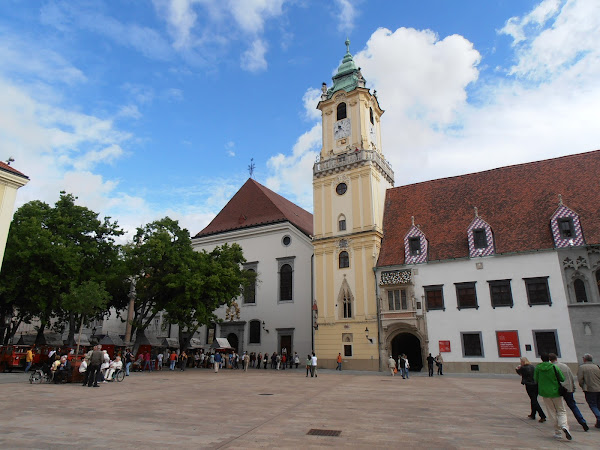























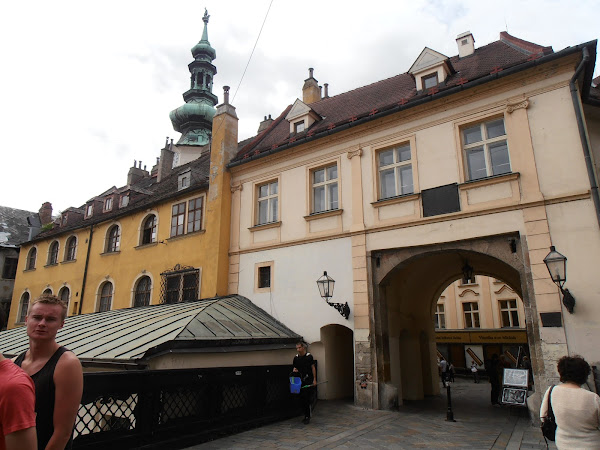


































































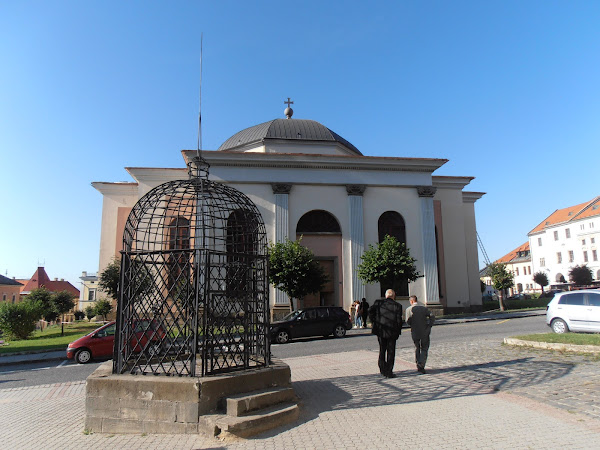

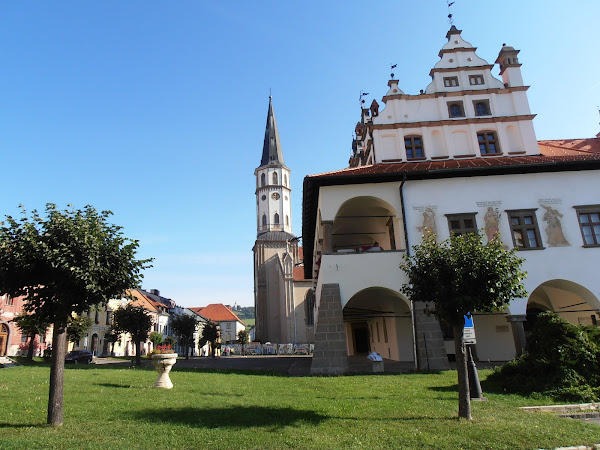








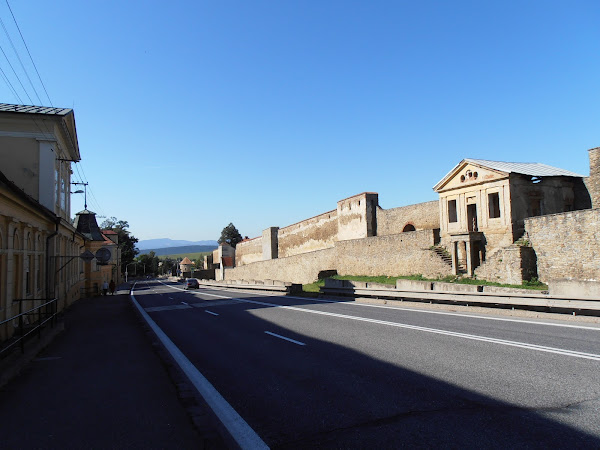


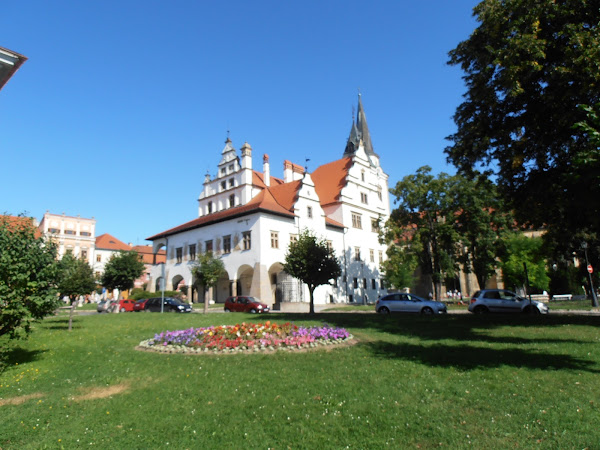
















































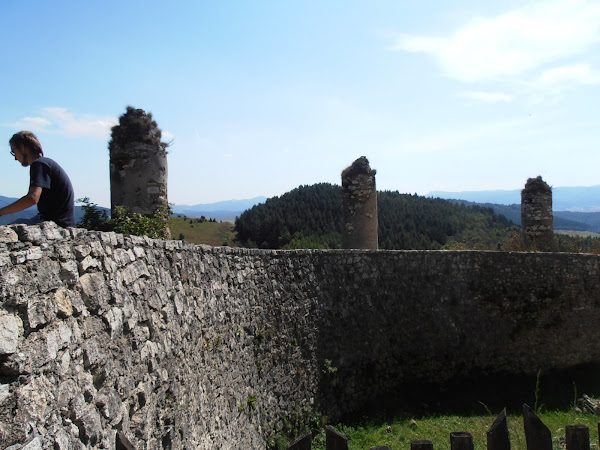





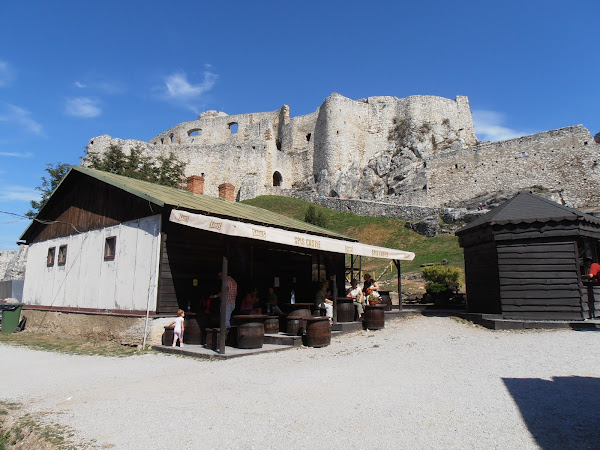





















































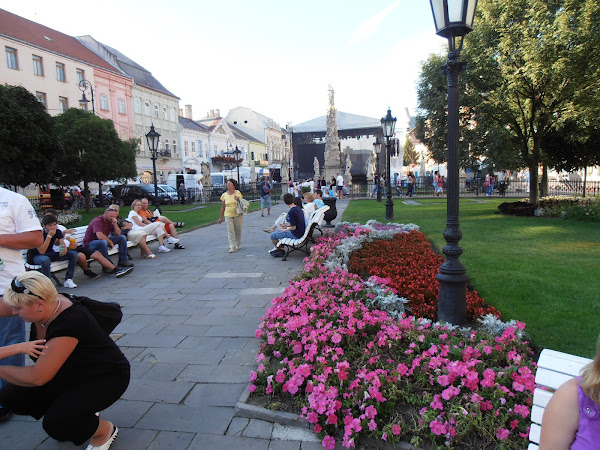

















































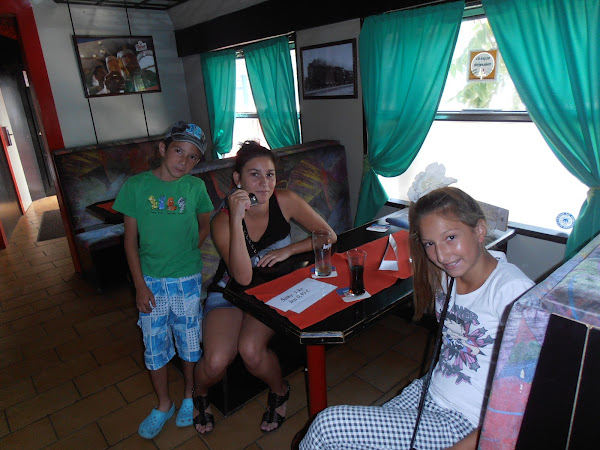
































































































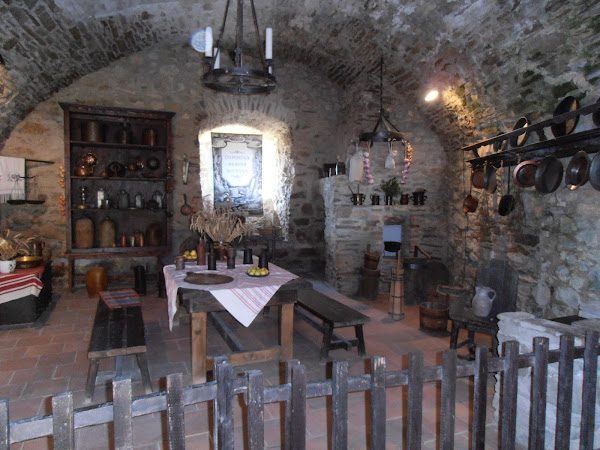














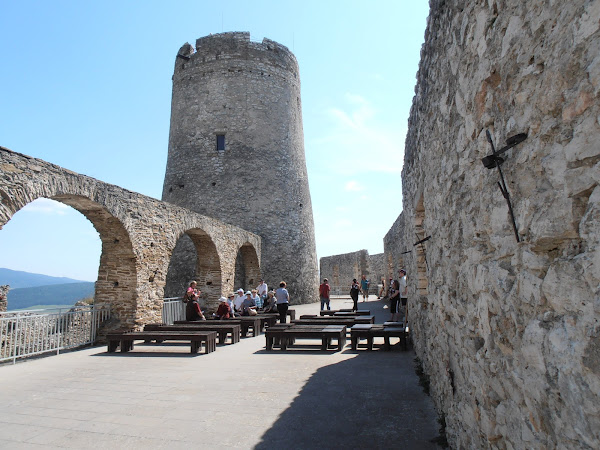






































































































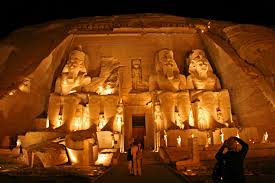
Comments
Post a Comment